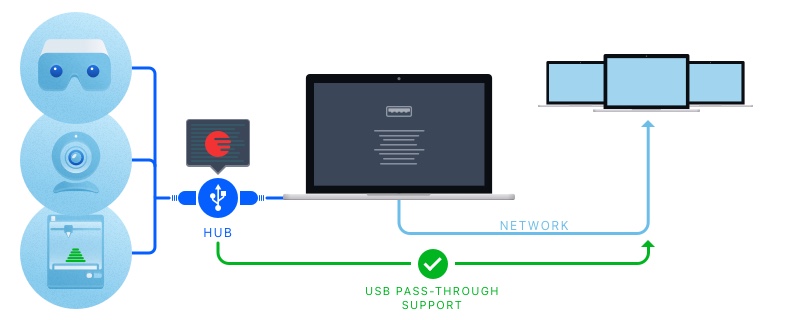It's a known fact that computers rely on USB devices to be able to interact with other consumer devices. For industrial equipment, it's the same. No one can deny the fact that USB cable remains an efficient means of transmitting data, as well a reliable way to establish communication between peripherals and home PCs or large industrial servers. But what if the need arises to connect to a device that is not within reach of the USB cable? Or share a piece of equipment among several users? Is this even practical? Let's discuss that.
Manufacturers of various USB hubs and USB to Ethernet adapters have long adopted the idea of sharing one USB port among several users. With such hardware solution in place, you can connect multiple devices to a single USB port on your computer at once. Or, simply put: you can share USB over Ethernet
However, the major drawback regarding hardware products is that they lack special USB pass-through technology, which means they are either limited by the cable (USB hub) length or become inefficient (USB over Ethernet connector). Also, it may be impossible to connect physically to a USB port or requires the use of other hubs that may be expensive.
Manufacturers of USB hubs continually strive to ensure that their devices are exceptionally valuable and they look for how to simply expand the functionality of their solution. Their main aim is the provision of hardware products capable of sharing USB ports over Wi-Fi networks or Ethernet.
Here's where Eltima Port Virtualization (EPV) solution steps in
With EPV technology, it's possible to virtualize and redirect USB devices over UDP or TCP networks so they can easily be accessible to a remote client computer. The connection here is achieved via a virtual USB port that is created in the client system. Consequently, EPV technology makes it possible to share a USB device over Ethernet or allow a remote USB device to be accessible to any network computer as if it was locally connected to the machine.
When you integrate the port virtualization technology into a USB to Ethernet adapter's operating system, the hardware solution turns into a full-featured tool used to share USB device over Ethernet.
- While the number of USB ports offered by many USB hubs is limited, Eltima software technology allows you to set up as many virtual COM ports as you want on your PC.
- Also, a shared USB device can be accessed by a limitless number of network computers. EPV technology makes it possible for Ethernet connectors to have the edge over its main competitors in the market. This allows manufacturers to acquire new market segments, increase its customer base, and improve company revenues.
- In turn, it offers end users flexibility they require in organizing their work process and reducing overall expenses.
